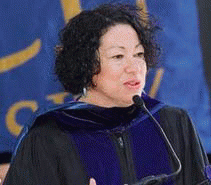The political sparrring over Sonia Sotomayor’s nomination to the U.S. Supreme Court is rapidly picking up steam, and it seems that all the initial blows are over several lines from her 2001 speech in Berkeley that was published the following year. In that speech, Sotomayor took issue with former Justice Sandra Day O’Connor’s purported statement that “a wise old man and wise old woman will reach the same conclusion in deciding cases.”
“I am also not so sure that I agree with the statement,” Sotomayor said, “First, as Professor Martha Minnow has noted, there can never be a universal definition of wise. Second, I would hope that a wise Latina woman with the richness of her experiences would more often than not reach a better conclusion than a white male who hasn't lived that life.”
“Here you have a racist – you might want to soften that, and you might want to say a reverse racist," conservative radio host Rush Limbaugh said of Sotomayor.
"Saying that someone would decide a case differently... because she's a Latina, not a white male, that statement by definition is racist," Ann Coulter said on "Good Morning America" today.
Newt Gingrich chimed in too, suggesting that a white man nominated for the Court who said “my experience as a white man makes me better than a Latina woman" would have to withdraw his nomination and, therefore, Sotomayor should withdraw as well.
Similarly Fox News host Megyn Kelly accused Sotomayor of saying "that Latina judges are obviously better than white male judges,” and ABC correspondent Jan Crawford Greenburg claimed that Sotomayor “suggest[ed] that a wise Latino may actually be a better judge than a white man.”
At first blush, it might seem that such accusations have merit, but as the media watchdog organization Media Matters explains, all of the above comments are taken out of context.
Sotomayor is specifically discussing race and sex discrimination cases, and this is clearly evident in the speech’s previous paragraph. As such, she is not saying that her experience as a Latina makes her a better judge. She is saying that her life experiences provide her with perspectives on these specific cases that white men do not have and that these additional perspectives benefit her deliberations.
Basically, what Sotomayor is doing in this speech is examining the influence of her ethnicity on her life and giving voice to some of the complexities of being not only a judge but also a woman and a person of color. Is this racist? Or sexist? Only if you think that we are able to leave all our life experiences at the door when we come to the workplace.
The almost exclusively white men who have historically made up the U.S. Supreme Court have always ruled, in part, on the basis of their lived experience. But because they were part of the privileged majority, it occurred neither to them nor their observers to question how their whiteness or their maleness affected their thinking. Sotomayor is not doing anything different from her predecessors. The difference is that because she is a woman of color we’re asking these questions…and she’s answering them. Rather well, I think.
And yet, racism is, in fact, part of this story.
While the accusations of “racism” in Sotomayor’s speech are completely off the mark, the conservative response to Sotomayor’s nomination is telling and merits some further scrutiny.
What all of the quoted comments have in common is that rather than discussing her considerable judicial record, the focus seems to be entirely on her status as a woman of color and whether this status should disqualify her from sitting on the Supreme Court.
Never mind that the “concerns” are framed not around her racial/ethnic status itself but around her supposed (and already discredited) “racist” comments about being a better judge than white men and whether she would prioritize Latino (and female) interests over those of the white majority. This circumvention is just the face of modern racism. It is not acceptable today to explicitly attack individuals because of their race or ethnicity...so the attack is on someone expressing their racial/ethnic identity in some way, for acknowledging that it is part of who they are and part of how they approach their life and work.
Not convinced? Consider this:
We are not in the habit of asking white judicial nominees whether they would privilege White interests or male nominees whether they would privilege male ones. The fact that such questions are being asked at all of Sotomayor– and asked en masse by both the media and the political elite – suggests that, despite conservative claims to the contrary, we are not yet in a post-racial society. More than that, they show either deliberate racial bias as Tom Tancredo does (he has a history of using fear tactics over immigration in his Presidential campaign ads) or incredible lack of consciousness about racial double-standards. As blogger John Amato pointed out, this isn't the pot calling the kettle black. It’s the pot calling out the tablecloth.





